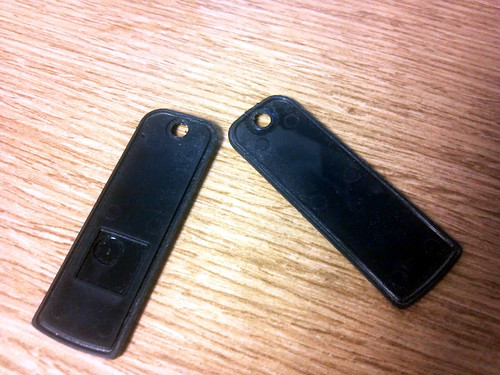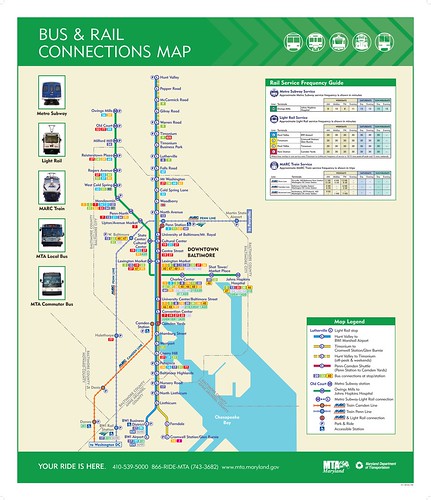From the ‘did you ever wonder’ file, the inside of a Capital Bikeshare fob. Mine was black because I was one of the original members; newer fobs are red.

May 30th, 2012 | Permalink
Tags: bike, Did you ever wonder, transportation
|
|
Blog
From the ‘did you ever wonder’ file, the inside of a Capital Bikeshare fob. Mine was black because I was one of the original members; newer fobs are red.
 Average Rating: 4.7 out of 5 based on 199 user reviews.
May 30th, 2012 | Permalink

Space ships are cool. They count as transportation, right? Sure they do. Why not. So congratulations to SpaceX, an American company, for successfully launching its own space ship and docking it with the International Space Station. The ship, called Dragon, is an unmanned cargo vessel delivering supplies, but a manned version capable of carrying astronauts is expected to make its first flight in 2014. OK OK. The urbanist connection here is tenuous. But I like space ships and this is a big deal. Average Rating: 4.9 out of 5 based on 214 user reviews.
May 25th, 2012 | Permalink
 For years Baltimore has lacked a consolidated rail system map. Rather, they had separate maps for the Metro-Subway, light rail, and MARC, even though all are run by the same agency. This made navigating the city’s rail system unnecessarily difficult, since users hoping to transfer between the various rail modes had to consult multiple maps. Finally, late in 2011, a consolidated rail map for Baltimore was published. It’s not the world’s greatest example of graphic design, actually it’s quite awful from that perspective, but at least it’s functional. It is easily the most fully integrated rail system map I’ve ever seen for the city.
 The map is one part of an entire series of new transit maps produced by MTA for the Baltimore region. There are several interesting maps in the series, including a diagrammatic bus system map (as opposed to a geographical one), and a WMATA map showing MTA bus connections. Average Rating: 4.6 out of 5 based on 228 user reviews.
May 24th, 2012 | Permalink

The fact that young people today are giving up cars in record numbers has become a fairly common meme lately. It’s a good story, being such a tremendous shift in the American Dream. So I was not surprised to see today’s Express cover story on the issue, which also appeared in the full Washington Post. But I did laugh when I got to the end of the story. It’s a perfectly good piece, but it closes with some nay-saying from a professor Michael Marsden, of Saint Norbet College. He says: “If you look at Main Street America on weekends, they’re still driving up and down Main Street… Are we really ever going to get over the love affair? I doubt it. Automotive culture, that love affair is a deep one. And we may have to compromise, we may have to shift, we may have to redefine it, but it’s a pull. It’s a deep, deep pull.” I’d never heard of professor Marsden or Saint Norbet College, so I looked them up. I won’t speculate on his precise age, but it’s clear from the picture that he’s firmly a member of one of the generations that viewed cars as a symbol of freedom rather than a burden. Meanwhile, Saint Norbet is located in a suburb of Green Bay, Wisconsin, which can hardly be described as a major participant in America’s urban renaissance. So let me get this straight: An old person in a suburb of a small, remote city isn’t impressed by the trends of today’s urban youth. Surprise! I don’t mean to pick on professor Marsden. I’m sure he’s a lovely man. And of course, it’s extremely unlikely that cars will ever disappear entirely. They’re wonderfully useful tools, after all. But I wonder if Marsden knows that his statements aren’t really a defense of car culture so much as they are further illustration of the generation gap. What better proof could the Post have shown than to end a story filled with quotes from young people with one from an old guy about how he thinks they’re all wrong? Average Rating: 4.9 out of 5 based on 275 user reviews.
May 22nd, 2012 | Permalink
 Apparently a report was published in November containing conceptual renderings of what the Dulles Metro station might look like.
Average Rating: 5 out of 5 based on 239 user reviews.
May 18th, 2012 | Permalink

Last weekend WMATA ran trains 30 minutes apart along the entire Orange Line. Although some reduction in service was necessary due to single tracking between Eastern Market and Cheverly, such extremely infrequent trains along the rest of the line was unnecessary and was a disservice to Metro’s customers. Metro’s job is not merely to run trains. It’s to serve customers who ride trains. Occasionally it is necessary for customers to be inconvenienced for a short while in order to provide long term improvements, but when that happens WMATA must do its best to minimize the inconvenience and provide adequate alternates. Last weekend they failed to do so. The single tracking between Eastern Market and Cheverly was planned in order for WMATA to perform a range of repairs and reconstruction going on through that segment. Half hour headways may have been necessary to ensure worker safety and maximize efficiency, so that the work could be completed prior to Monday’s rush hour. That’s all perfectly justifiable. But there was absolutely no reason for riders along the entire length of the Orange Line to be left with such terrible service. Metro’s track schematic clearly shows there are crossover tracks between Federal Center SW and Capitol South stations. Trains coming and going west from Federal Center SW could have used that crossover track to turn around, ensuring regular weekend headways through downtown Washington and in Virginia. We know trains can turn around using the crossover tracks since they do it every day at Mount Vernon Square and Grosvenor, so why couldn’t they have done so last weekend at Federal Center SW? This simple solution would have prevented thousands of Metro customers from being greatly inconvenienced. It’s possible that Metro had repairs under way elsewhere along the Orange Line, but the press release didn’t communicate that. In any event, there are crossover tracks every few stations all throughout the system. Trains could have turned around at McPherson Square, Foggy Bottom, or Clarendon, and at least riders west of the turnaround wouldn’t have been faced with 30 minute waits. Sometimes officials forget that keeping the rail system in proper order is a means to an end, not an end in and of itself. If the system isn’t serving customers then it’s not working. The next time Metro has to perform single tracking, they should use one of the system’s many turnarounds to ensure short headways along the rest of the line. Average Rating: 4.5 out of 5 based on 208 user reviews.
May 17th, 2012 | Permalink
 What do you if your city is built around a narrow river and needs a major grade-separated rapid transit line, but for whatever reason you can’t afford a subway? Why, you build a rivertop monorail, of course! That’s what the city of Wuppertal, Germany did way back in 1897, when it built the Schwebebahn, or “floating train.” It’s been open and running ever since, except for a time during World War II when it was damaged. Monorails have a fairly limited useful niche. They’re more expensive and less flexible than light rail, and have a more limited capacity than heavy metro rail. Their main advantage over traditional elevated rail is that their structure can be airier-looking, and therefore prettier. Generally speaking, monorails are only useful if you’re going to build a rail line that you know will be 100% elevated, and if you’re worried a lot about aesthetics. A line running on top of a river is basically the perfect place. Just about anywhere else, you’d build something more traditional. Anyway, the Schwebebahn is fascinating. Certainly it’s one of the world’s most unique transit lines. Here are a couple of pictures:
Average Rating: 4.4 out of 5 based on 295 user reviews.
May 16th, 2012 | Permalink
 This lulzy internet graphic has been floating around for years. Unfortunately, it really does often work this way.
 Flowchart drawn by David Alpert at GGW. Average Rating: 4.8 out of 5 based on 215 user reviews.
May 15th, 2012 | Permalink

Maryland has officially finalized its planning for the Corridor Cities Transitway (CCT). In so doing the state has finally answered a number of lingering questions about the Gaithersburg-to-Clarksburg route.
Overall, the adopted plan addresses many of the problems I identified in 2006. It’s not perfect, but it’s workable, and it will have a hugely positive effect on how Gaithersburg operates. Maryland can now move the project into the federal government’s New Starts process, where it will compete with other projects around the country for funding. Ideally they will move into more specific engineering in another year or so, with construction beginning in 2018 and service beginning on the first phase in 2020. Average Rating: 4.9 out of 5 based on 283 user reviews.
May 14th, 2012 | Permalink

Last week Maryland announced $2.5 million in grants to develop bikesharing in the state. The money is on top of funds already dedicated to bikesharing in Baltimore and Rockville. Since plenty of funding is now committed and planning work is well underway, it seems like a good time to catch up on where bikesharing stations are due to be installed. This information doesn’t seem to be available at any other centralized location, so here you are:
Average Rating: 4.5 out of 5 based on 256 user reviews.
May 10th, 2012 | Permalink
 |
Media Tweets by @beyonddc
Follow @beyonddc
Site
Partners
|
||||||||||||||||||||||||||||||||||||||||||||||||||||||||||||||||||||||||||||||||||||||
|